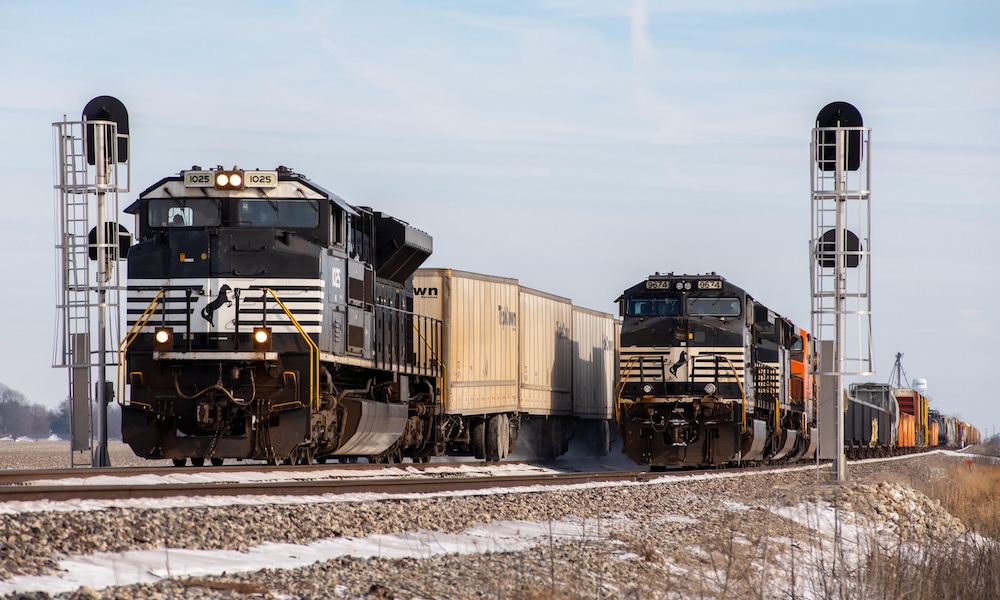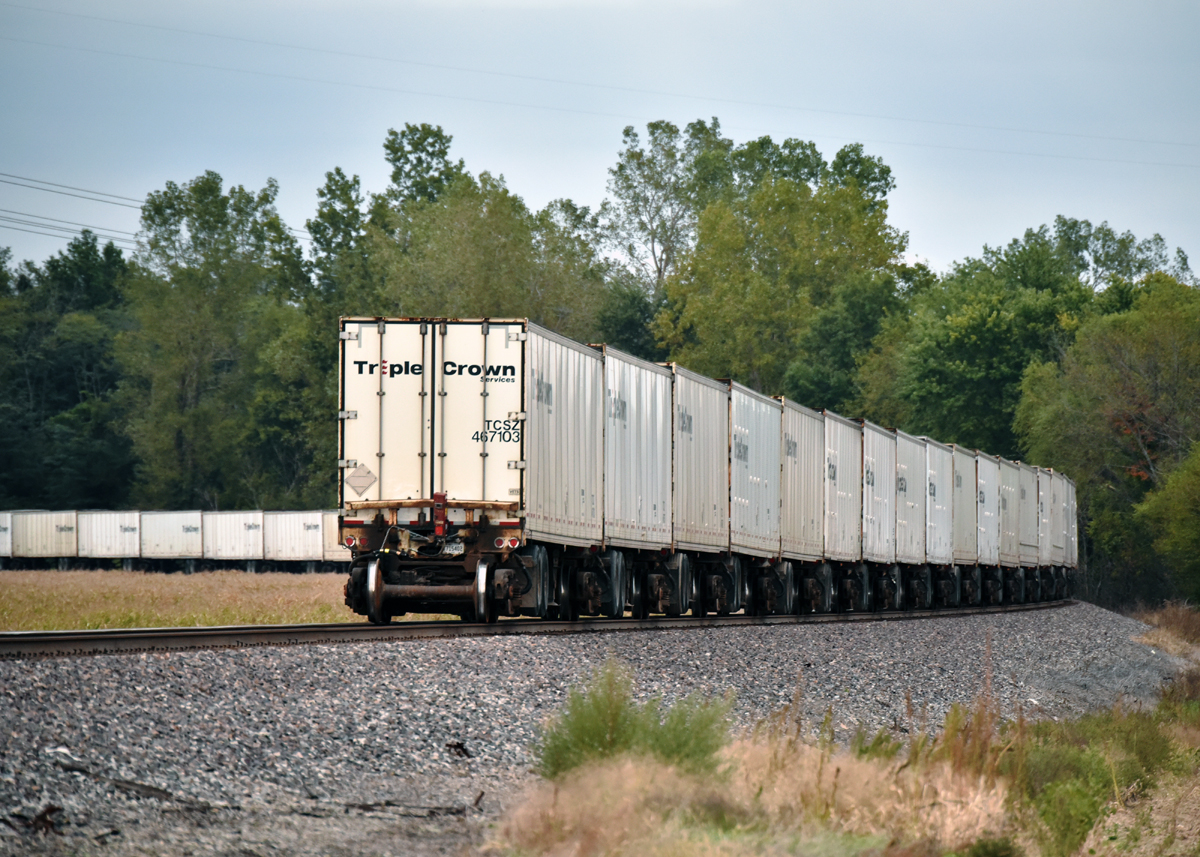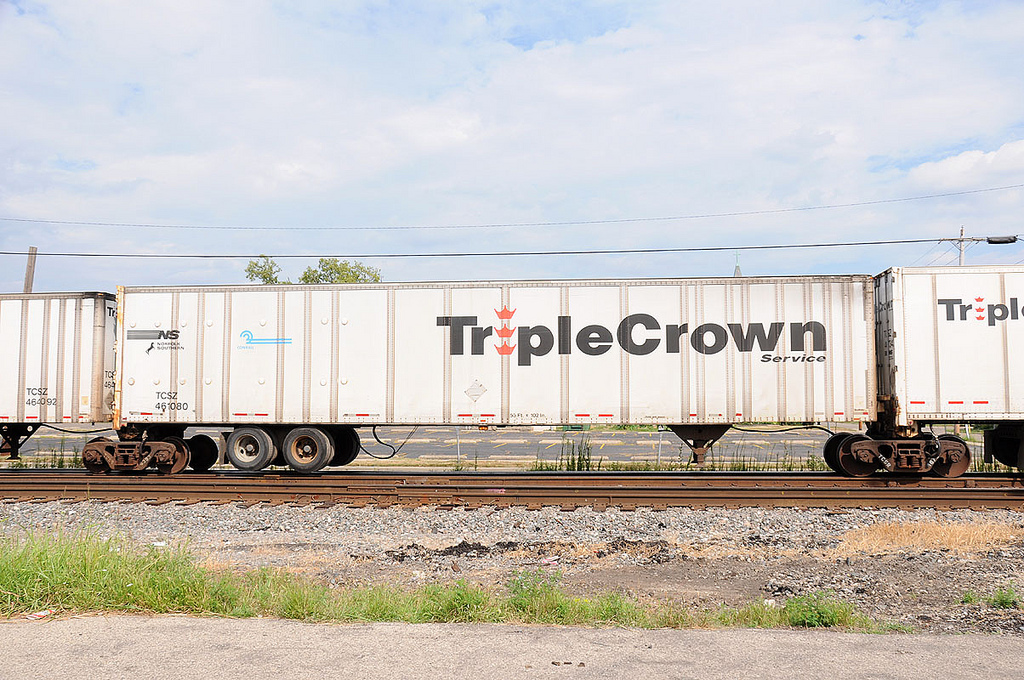
ATLANTA — RoadRailer has reached the end of the line.
The last runs of Norfolk Southern Triple Crown RoadRailer trains 255 and 256 are scheduled to depart their respective terminals outside of Detroit and Kansas City on the weekend of Aug. 24-25.
The freight the aging equipment carries — auto parts in general and particularly those bound for Ford Motor Co.’s Kansas City Assembly Plant, which builds the F-150 pickup and Transit Connect van — will continue to move on Norfolk Southern rails.
But the trains’ eastern terminal will shift to Toledo, Ohio, after the last runs of the dedicated RoadRailer trains. The RoadRailer trailers will ride as TOFC moves for a few days or weeks during a transition period, with Triple Crown 53-foot domestic containers mixed in. And then the RoadRailer trailers will be replaced entirely by Triple Crown domestic containers that will ride in conventional double-stack service on Toledo-Kansas City hotshots 255 and 256.
Stefan Loeb, Norfolk Southern’s vice president of business development and first and final mile markets, says there are two reasons for the shift from RoadRailers to domestic double stack service.
“The first is the age of the equipment. All equipment reaches its end of life, and what you don’t want to do with critical business like we have with all of the auto parts users is to end up without a product,” Loeb says.
A service failure runs the risk that an assembly plant would be forced to suspend production due to delayed auto parts shipments. The old and specialized RoadRailer equipment requires more maintenance, Loeb says, so it’s a good time to take the remaining rail bogeys and 1,250 RoadRailer trailers out of service.

“And that transfers to the second fundamental reason,” Loeb explains. “It allows us to not just continue to provide great service through existing standard equipment, but because it will be standard equipment it amplifies the ability to take the service to other areas.”
With RoadRailer equipment confined to the Detroit-Kansas City route, Triple Crown couldn’t compete with trucks for auto parts business in other lanes. Triple Crown is the NS subsidiary that provides door-to-door service, a requirement for handling auto parts. Triple Crown also handles first- and final-mile dray moves for some intermodal marketing companies and bulk transload shipments.
The RoadRailer concept dates to the 1950s on Chesapeake & Ohio. The railroad operated bimodal vans, mostly on the rear of Pere Marquette passenger trains in Michigan, for only a few years.
NS revived the idea when it launched Triple Crown Services in 1986 to haul auto parts between Detroit and St. Louis. A Chicago-Atlanta service was added two years later via the Triple Crown hub at Fort Wayne, Ind. Conrail became a partner in Triple Crown in 1993, and eventually the Triple Crown RoadRailer network blanketed the East and reached beyond the NS system to destinations including Minneapolis, Toronto, Fort Worth.
The RoadRailer bimodal system — which allows trailers to ride on rail bogeys and be coupled together in trains as long as 150 units — was revolutionary, Loeb says. Although Amtrak, BNSF, CSX, Canadian National, and Union Pacific all flirted with RoadRailer operations at one time or another, the system never gained sustained, widespread acceptance beyond Triple Crown.

In 2015, NS pruned the Triple Crown network to just the Detroit-Kansas City lane after deciding not to update the fleet. Most of the RoadRailer freight went back to the highway, and Triple Crown’s volume plunged by 80%.
“This was a very transformative technology that worked. And the real beauty of it is it allowed us to keep a business that a lot of railroads lost or struggled with over the years,” Loeb says.
“I know a lot of people will see the sadness of it going away,” he says. But because RoadRailer lasted as long as it did on NS, it gave Triple Crown a bridge to a new growth-oriented era on the railroad. “It’s given us the opportunity to go back to its original plan, which was door-to-door auto parts across our network,” Loeb says.
To accommodate the shift from Detroit to Toledo, NS made investments in additional parking spaces and new gates at the Toledo terminal. It also is prepositioning empty containers to handle the first loads out of Toledo, which is more centrally located for auto parts manufacturers in Ohio.
The Toledo-Kansas City transit time for the stack trains will be the same as the Detroit-Kansas City RoadRailers they are replacing. “It has to be, right? The automakers demand it,” Loeb says.
Other intermodal customers will be able to take advantage of the capacity that will be available on the stack train, Loeb says. And by using conventional containers there’s a potential to develop new interline intermodal service through Kansas City to Mexico, which has become an automaking powerhouse that relies on parts produced in the Midwest.
“Kansas City’s obviously a very interesting gateway for us with our connecting partners,” Loeb says. “A lot of work would have to be put together to do that, but it’s definitely possible.”
The 255-256 stack service will use Norfolk Southern’s former New York Central Water Level Route between Toledo and Butler, Ind., where there’s a connection to the former Wabash main line to Kansas City.
The final 256 RoadRailer is scheduled to depart from Voltz, Mo., at 12:01 a.m. on Aug. 24, while counterpart 255 will depart Oakwood, Mich., for the final time at 2:20 a.m. on Aug. 25. The trains typically run in daylight across Illinois on Norfolk Southern’s former Wabash main line.
The 256 is scheduled for a 3:40 a.m. arrival at Oakwood the next day. The 255 is scheduled to pull into Voltz at 2:40 a.m. on Aug. 26, which will bring down the curtain on Norfolk Southern’s 38-year RoadRailer experiment.














I used to enjoy watching 251/252 coming through Chattanooga, crying shame it will be gone forever.
will we be seeing triple crown intermodal containers throughout the norfolk southern railway ?
And then the RoadRailer trailers will be replaced entirely by Triple Crown domestic containers that will ride in conventional double-stack service on Toledo-Kansas City hotshots 255 and 256.
Sad to see such an innovative idea come to an end. Although the equipment had issues, the concept seemed to have much potential and many advantages.
However . . . as Yoda said . . . there is another:
https://railrunner.com/
Such creative ideas are interesting to see but this alternative has also struggled to gain traction.
Another unfortunate swap of unique with boring. Adios Roadrailers…
TCS had one helluva ride. Congrats to NS for putting a substantial investment ($40 Million) in the staff and equipment to originally fuel this innovative “truck like” service. The result was truly “A Green Light To Innovation That Took The Waste Out Of Distribution”.
I understand the reasons why NS has decided to sunset RoadRailer service. But, I am curious about how much fuel consumption will increase and how much more power will be required with double stacks.
There won’t be. Double-stack is the most fuel efficient form of intermodal. DS has a roughly 20% fuel savings over TOFC. My guess is COFC has 10-15% fuel advantage over Roadrailer. Remember you’re doubling capacity with lighter rolling stock.